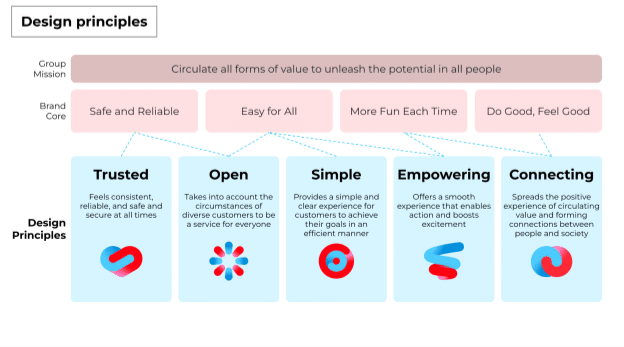
The Path to Making Secondary Distribution a Standard Part of the World—Meet Mercari’s Leaders, Vol. 3: Miho Maekawa (CXO Marketplace)
“What can I provide to our users and to society at large?”
This simple yet profound question defines the ongoing pursuit of Miho Maekawa (@Miho), Chief Experience Officer (CXO) of Marketplace at Mercari. Miho creates the vision for the Mercari user experience from start to finish, and manages every step from establishing strategies to implementation of the end product.
From the early days of UX design, Miho built her experience working at companies such as Microsoft Corporation and later Fast Retailing. In this article, we ask her about how her past experience ties to the work she does now, as well as her views on Mercari’s user experience as CXO.
Featured in this article
-

Miho MaekawaAfter graduating from an art university in the US, Miho joined Microsoft as a UX designer and worked on the launch of the company’s portal site and its global expansion. She transferred from the US to Microsoft Japan in 2008, where she was in charge of developing the UX design of its news media in Asia. In 2015, she joined Fast Retailing as the company’s very first UX designer and helped establish the retail giant’s entire design organization. Miho led the UX design of internal and in-store systems and the online site of each brand at Fast Retailing, before moving to Mercari in May 2022 as the Head of Design (Marketplace). In January of 2023, she was appointed VP of Experience Design and became CXO of Marketplace in June of the same year.
Delivering an experience that makes our users happy and brings real improvements to society
—To kick things off, what led you down the path of design? Tell us about the experiences that brought you to where are you today.
When I was a student, I enrolled in an American arts university where I majored in graphic design. As we were in the early years of digital design at the time, it was not an established part of design either professionally or as a topic of study. I didn’t necessarily feel drawn to digital design at first. My interest grew from a web programming class where I happened to learn about it by chance.
As for how I’ve applied my studies from my time at art school in the States to my current work, I’d say that I learned how important it is to know how to sell your work and yourself. Some of the art pieces that students at my university produced were not necessarily high in quality, but with a well-explained concept, they were evaluated highly. It’s not just about the art you create, but also about how you captivate the viewer and convey the meaning of your work.
—Could you describe what your career was like after graduation?
I joined Microsoft Corporation in the US as a product designer where I was put in charge of designing the company’s portal site and launching it globally. I mainly worked on balancing the placement of advertisements and site content on the home page and spent a lot of time contemplating how to monetize the space.
My work as a UX designer started sometime around 2015. At my previous job at a major fashion retailer, I was the company’s very first UX designer. While people generally had an awareness of graphic and product design, I initially had a hard time getting people to understand what my purpose and role were as a UX designer—a term that many people were not familiar with.
That was when I recalled my experience in the States and decided to convey to my co-workers how a UX designer could contribute to our users and to the company. Today, as CXO, I continue to leverage these experiences as I work with a sense of purpose toward making our users happy and improving society.
Pursuing Mercari’s identity guided by design principles rather than growth indicators
—In your interview as VP of Experience Design (available only in Japanese), conducted in April 2023, you talked about launching a design organization. How has it progressed since then?
After I assumed the role of CXO in June 2023, we launched the CXO Division, which merged product and engineering teams into a single organization. We’ve gone beyond the boundaries of design by also providing direction for both the company and the CXO Division, incorporating our vision of the user experience into the product, and materializing every step of the user experience little by little.
This was the first time I was involved in committing to not an individual but a division-wide project to incorporate user experience into the product and aim for a sales target. This was the biggest challenge of my career to date.
—You worked on the Mercari Design Principles around the time you became CXO, right?
Correct. The Mercari Design Principles are a policy designed in order to provide a consistent brand experience at every touchpoint with our users. We had meetings with the members who were involved in design, asked for their thoughts, and then compiled everything.

—How did people within the company respond to the Mercari Design Principles once they were released?
I get the sense that the Mercari Design Principles have been applied to a variety of projects. In addition, with the creation of a common language for design, it’s now easier for us to pursue Mercari’s identity.
Setting aside whether the principles contribute to short-term growth, they certainly have been successful in crafting the safe, easy-to-use, and fun platform that Mercari values, allowing for enjoyable interactions between buyers and sellers. Most recently, we added a feature that allows users to send emojis with in-app messages.
—Beyond the realm of our product, what are your views on our overall corporate branding and design?
I mainly consider the experience of our current users, but I think it’s also important to consider the overall experience of all of the stakeholders of design, including Mercari members and potential future users.
Through our various touchpoints, I would love for people to think of Mercari as a company with potential, one that not only generates revenue but also contributes to society.
Coordinating with the government and other companies to bring excitement to secondary distribution
—As CXO, what do you see as Mercari’s future outlook?
In order to achieve our Group mission, “Circulate all forms of value to unleash the potential in all people,” I would like us to make secondary distribution a standard part of the world.
Through Mercari, I would like us to infuse new value into items that people have regarded as worthless to date and to transform the act of “disposing of things” into “passing things on.” In this way, I hope that secondary distribution will become a way of life for our users.
Achieving this will require the effort of more than just Mercari. We need the cooperation of the government and of other companies as well. Compared to places like Europe, where people have a high level of awareness of the environment, Japan is still lacking in social restrictions around waste disposal.
For instance, when people shop for something like vegetables at a supermarket, they generally weigh and purchase only what they need, but in Japan, most things are sold packaged in plastic. In that sense, I feel like Japan is less developed than other nations.
I would like Mercari to play a part in helping to change the social norm of buying, consuming, and disposing.
—Do you think our members are incorporating Mercari’s Group mission in their daily tasks?
There may be aspects of what Mercari aims to achieve that have not yet been incorporated into the work of individual members. I think it’s also important to break things down with more specificity, such as defining who “all people” refers to in our Group mission and creating guidelines on how to work toward the mission.

—Finally, could you share with our readers what sort of people you personally would like to meet as Mercari job applicants?
Ideally, I would like any prospective members to have both a sense of purpose and to be flexible. They should sympathize with Mercari’s mission and have a sense of purpose at their core but remain flexible and open-minded. If you have an interest in the ideas and perspectives of diverse people and are able to adapt and change flexibly, then you’ll enjoy working on challenges with us at Mercari.
We want people who will do more than simply think in terms of their own role. Regardless of whether an issue falls under their responsibility or not, if they see a problem right in front of them, they should be willing to transcend their role and collaborate with others to find a solution. I look forward to meeting people with that kind of spirit.
Bonus: How I use Mercari!
I often buy clothes, flowers, and flower bulbs! I like to buy from the same users, so I use the bundle purchase feature. As for what I list on Mercari, I mostly sell clothes and old design books and magazines that I bought when I was in the US. Apparently, there are a lot of people who like to decorate their homes with magazines from overseas.
Maybe it’s because of the nature of the work that I do, but I’m kind of particular when it comes to the photographs I take when listing items. I use my flooring as the background in all of my photographs, and I only shoot using natural light, so I usually do all of my listing work in the morning. (laughs) With Mercari, there’s room for that kind of personal expression.
Going forward, I’d like to make Mercari into a product that can also convey value as a platform for diverse people to express their personality.
